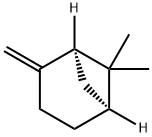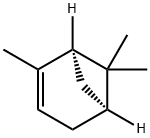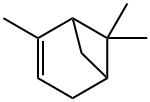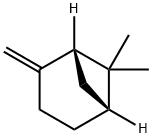(1S)-(1)-beta-Pinene
Synonym(s):(-)-beta-Pinene;(1S)-(−)-β-Pinene;(1S,5S)-2(10)-Pinene;(1S,5S)-6,6-Dimethyl-2-methylenebicyclo[3.1.1]heptane
- CAS NO.:18172-67-3
- Empirical Formula: C10H16
- Molecular Weight: 136.23
- MDL number: MFCD00001345
- EINECS: 242-060-2
- SAFETY DATA SHEET (SDS)
- Update Date: 2025-01-27 09:38:02

What is (1S)-(1)-beta-Pinene?
Description
(–)-β-Pinene is a bicyclic monoterpene that has been found in various plants, including C. sativa, with diverse biological activities. It is lethal to S. littoralis third instar larvae (LD50 = 65 μg/larva). (–)-β-Pinene inhibits infectious bronchitis virus (IBV) replication (IC50 = 1.32 mM) and exhibits a cytotoxic concentration (CC50) value of greater than 10 mM in Vero cells. In vivo, (–)-β-pinene (100 mg/kg) decreases immobility time in the forced swim test in mice, an effect that can be reversed by the serotonin (5-HT) receptor subtype 5-HT1A antagonist WAY-100635 .
Chemical properties
clear colorless to pale yellow liquid
The Uses of (1S)-(1)-beta-Pinene
It is a useful biochemical for proteomics research. It is also employed in the preparation of natural products, such as grandisol and robustadial. It is also applied as perfuming agent in cosmetics industry.
The Uses of (1S)-(1)-beta-Pinene
(-)-β-Pinene has been used as a standard for the analysis of terpenoid compounds in plant essential oils by GC analysis. It may be used as a building block to synthesize natural products such as grandisol, robustadial and (+)-nopinone. (-)-β-Pinene undergoes hydroformylation in the presence of platinum/tin catalysts to form trans-10-formylpinane.
What are the applications of Application
(?)-β-Pinene is a useful biochemical for proteomics research
Definition
ChEBI: (-)-beta-pinene is the (1S,5S)-enantiomer of beta-pinene. It is an enantiomer of a (+)-beta-pinene.
Properties of (1S)-(1)-beta-Pinene
| Melting point: | −61 °C(lit.) |
| Boiling point: | 165-167 °C(lit.) |
| alpha | -18.5 º (c=neat 25 ºC) |
| Density | 0.866 g/mL at 25 °C |
| vapor density | 4.7 (vs air) |
| vapor pressure | ~2 mm Hg ( 20 °C) |
| refractive index | n |
| FEMA | 2903 | BETA-PINENE |
| Flash point: | 91 °F |
| storage temp. | 2-8°C |
| solubility | 95% ethanol: soluble1ml/3ml, clear, colorless |
| form | Liquid |
| color | Clear colorless to pale yellow |
| Odor | at 10.00 % in dipropylene glycol. dry woody fresh pine hay green resinous |
| Odor Threshold | 0.033ppm |
| optical activity | [α]25/D 22°, neat |
| Water Solubility | insoluble |
| Merck | 14,7446 |
| BRN | 2038282 |
| CAS DataBase Reference | 18172-67-3(CAS DataBase Reference) |
| NIST Chemistry Reference | Bicyclo[3.1.1]heptane, 6,6-dimethyl-2-methylene-, (1S)-(18172-67-3) |
| EPA Substance Registry System | (-)-.beta.-Pinene (18172-67-3) |
Safety information for (1S)-(1)-beta-Pinene
| Signal word | Danger |
| Pictogram(s) |
 Flame Flammables GHS02  Exclamation Mark Irritant GHS07  Health Hazard GHS08  Environment GHS09 |
| GHS Hazard Statements |
H226:Flammable liquids H304:Aspiration hazard H315:Skin corrosion/irritation H317:Sensitisation, Skin H410:Hazardous to the aquatic environment, long-term hazard |
| Precautionary Statement Codes |
P210:Keep away from heat/sparks/open flames/hot surfaces. — No smoking. P273:Avoid release to the environment. P280:Wear protective gloves/protective clothing/eye protection/face protection. P331:Do NOT induce vomiting. P301+P310:IF SWALLOWED: Immediately call a POISON CENTER or doctor/physician. P303+P361+P353:IF ON SKIN (or hair): Remove/Take off Immediately all contaminated clothing. Rinse SKIN with water/shower. |
Computed Descriptors for (1S)-(1)-beta-Pinene
New Products
2,3-Dihydro-5,6-dimethoxy-2-(4-piperidinylmethyl)-1H-inden-1-one hydrochloride 3-Pyridineacrylic acid 2-pyridineacetonitrile Methyl 4-chloropyridine-2-carboxylate hydrochloride 1-Methyl-4-piperidinone 1-Boc-4-cyanopiperidine 2-Propanamine, 1-chloro-, hydrochloride (9CI) 3-Pyridineacetonitrile, α-hydroxy- 3-Iodophenylacetic acid 3-(hexyloxy)-4-(pyridin-3-yl)-1,2,5-thiadiazole 2-Hexyn-1-ol Dibenzo-18-crown-6 N N' DimethylEthylenediamine Lead II Bromide Variamine Blue B Diazonium salt Ethyl Methanesulfonate N Ethylmethylamine N N N'Trimethyl ethylenediamine (R)-2-Methylpyrolidine-2-carboxylic acid (De Mepro) Boc-his(trt)-OH Sacubitril- Valsartan Ramipril Fmoc-L-Glu-OtBu Boc LeucineRelated products of tetrahydrofuran






![BETA-PINENE, SYNTHETIC,BETA-PINENE, NATURAL,BETA-PINENE,6,6-dimethyl-2-methylenebicyclo[3.1.1]heptane (beta-pinene),l-beta-Pinene](https://img.chemicalbook.in/CAS/GIF/127-91-3.gif)

You may like
-
 (-)-β-Pinene CAS 18172-67-3View Details
(-)-β-Pinene CAS 18172-67-3View Details
18172-67-3 -
 (−)-β-Pinene CAS 18172-67-3View Details
(−)-β-Pinene CAS 18172-67-3View Details
18172-67-3 -
 52092-43-0 98%View Details
52092-43-0 98%View Details
52092-43-0 -
 Methyl-2-chloro pyridine-5-carboxylate 98%View Details
Methyl-2-chloro pyridine-5-carboxylate 98%View Details
58481-11-1 -
 Tetrahydropiperin 23434-88-0 >98%View Details
Tetrahydropiperin 23434-88-0 >98%View Details
23434-88-0 -
 N,N,N',N'-Tetramethylmethylenediamine Or Bis(dimethylamino)methane 51-80-9 98%View Details
N,N,N',N'-Tetramethylmethylenediamine Or Bis(dimethylamino)methane 51-80-9 98%View Details
51-80-9 -
 Nicotinic acid N-oxide 2398-81-4 98%View Details
Nicotinic acid N-oxide 2398-81-4 98%View Details
2398-81-4 -
 695-34-1 2-Amino 4-Methyl Pyridine 98%View Details
695-34-1 2-Amino 4-Methyl Pyridine 98%View Details
695-34-1
